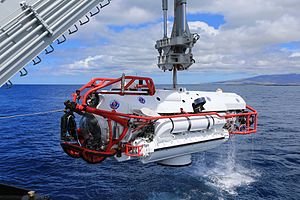 The LR-7 being retrieved by Changdao during RIMPAC 2016.
| |
| Class overview | |
|---|---|
| Builders | Forum Energy Technologies (FET) [2] |
| Operators | |
| Preceded by | 35-ton deep-submergence rescue vehicle |
| In service | 2009 - present[1] |
| History | |
| Name | LR7 |
| In service | 2009[1] |
| Status | Active |
| General characteristics | |
| Type | Deep-submergence rescue vehicle |
| Displacement | 38 tons (full)[3] |
| Length | 9.6 metres (31 ft)[1] |
| Beam | 3.2 metres (10 ft)[1] |
| Draught | 3.4 metres (11 ft)[1] |
| Installed power | Lead-acid batteries[1] |
| Propulsion | |
| Speed | 3 knots (5.6 km/h; 3.5 mph)[1] |
| Capacity | 18 survivors[1] |
| Crew | 3[1] |
The LR7 is a deep-submergence rescue vehicle (DSRV) of the People's Republic of China's People's Liberation Army Navy (PLAN). It was built by Perry Slingsby of Britain and is a development of the LR5 DSRV. The LR7 entered service in 2009.[1]